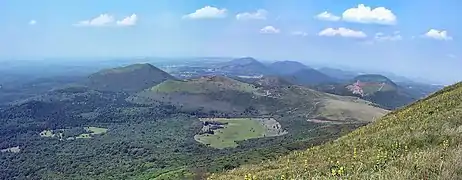Chaîne des Puys
The Chaîne des Puys (French: [ʃɛn de pɥi]) is a north-south oriented chain of cinder cones, lava domes, and maars in the Massif Central of France. The chain is about 40 km (25 mi) long, and the identified volcanic features include 48 cinder cones, eight lava domes, and 15 maars and explosion craters.[1] Its highest point is the lava dome of Puy de Dôme, located near the middle of the chain, which is 1,465 m (4,806 ft) high.[1] The name of the range comes from a French term, puy, that refers to a volcanic mountain with a rounded profile. A date of 4040 BCE is usually given for the last eruption of a Chaîne des Puys volcano.[2]
| Chaîne des Puys | |
|---|---|
 View of the Chaîne des Puys from Puy de Dôme | |
| Highest point | |
| Elevation | max. 1,464 m (4,803 ft) at Puy de Dôme |
| Coordinates | 45.5°N 2.8°E |
| Geography | |
 Chaîne des Puys Location of Chaîne des Puys | |
| Location | Auvergne-Rhône-Alpes, France |
| Parent range | Massif Central |
| Geology | |
| Age of rock | From 7,000 to 95,000 years |
| Mountain type | cinder cones, lava domes, and maars |
| Last eruption | 4040 BCE ± 150 years |
| Official name | Chaîne des Puys - Limagne fault tectonic arena |
| Type | Natural |
| Criteria | (viii) |
| Designated | 2018 |
| Reference no. | 1434 |
| State Party | |
| Region | Western Europe |
The location became a World Heritage site in 2018.[3]
Formation
The chain began to form approximately 95,000 years ago, and the volcanic activity that formed the range stopped about 10,000 years ago.[1] The majority of the cones were formed by Strombolian eruptions, and these cones usually have well-defined summit craters. Some have nested craters, and others show broken rims where lava poured through.[1]
In contrast, Puy de Dôme was created by a Peléan eruption; this type of eruption is characterized by long dormant periods periodically interrupted by sudden, extremely violent eruptions.[1]
Research
The chain was the subject of the pioneering research of English geologist George Julius Poulett Scrope, starting in the 1820s. In 1827 he published his Memoir on the Geology of Central France, including the Volcanic formations of Auvergne, the Velay and the Vivarais, which was later re-published in a revised and somewhat more popular form in The Geology and extinct Volcanos of Central France in 1858. These books were the first widely published descriptions of the Chaîne des Puys, and the analysis therein laid the foundation for many of the basic principles of volcanology.
References
- Scheffel, Richard L.; Wernet, Susan J., eds. (1980). Natural Wonders of the World. United States of America: Reader's Digest Association, Inc. pp. 306–307. ISBN 0-89577-087-3.
- "Chaine des Puys". Volcano World. Oregon State University. Retrieved 18 February 2016.
- "Chaine des Puys - Limagne fault tectonic arena". UNESCO.
Bibliography
| Wikimedia Commons has media related to Chaîne des Puys. |
- Scrope, George Poulett (1858). The Geology and extinct Volcanos of Central France. J. Murray, London. pp. 258. ISBN 0-405-10459-6. (reprinted in 1978 by Arno Press)
- Scarth, Alwyn; Tanguy, Jean-Claude (2001). Volcanoes of Europe. Oxford University Press. pp. 243 pp. ISBN 0-19-521754-3.
- Cattermole, Peter (2001). Auvergne (Classic Geology in Europe 2). Terra Publishing. pp. 176 pp. ISBN 1-903544-05-X.
- "Chaîne des Puys". Global Volcanism Program. Smithsonian Institution.
- Boivin Pierre; et al. (2004). Volcanologie de la Chaîne des Puys, Massif Central Français. Clermont-Ferrand: Parc Naturel Régional des Volcans d'Auvergne. OCLC 634970268.